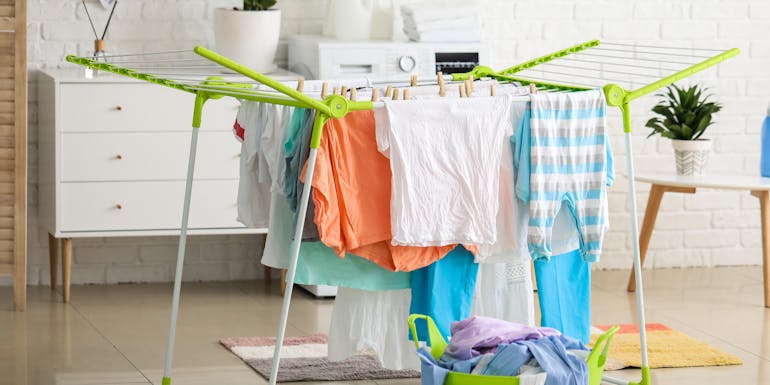
Lea Bieri, 27 July 2022
Living room
Drying your washing indoors
A practical and very popular solution is drying your washing indoors. Because the moisture from the washing disperses in the air indoors, there are a couple of points that you need to take into account. Air-drying your washing indoors is not prohibited by law per se in Switzerland. However, both tenants and homeowners will have to foot the bill for any damage that this may be cause. We will show the dangers that lurk when drying your washing indoors, how to avoid them and how to dry your washing correctly.
Firstly, the best place for your clothes to dry quickly is in a drying room with integrated dehumidification. Or outside in the shade in summer – however this is not an option for all households. Many people have no choice but to hang out their freshly laundered clothes to dry indoors.
As already mentioned, drying your washing indoors is not prohibited under tenancy law in Switzerland. However, you will have to pay for any resulting damage yourself. One of the most common types of damage is the formation of mould: wet washing increases the level of humidity indoors. If the level of humidity was already more than 55% before you hung out your washing, the additional moisture will be deposited on it, promoting the growth of mould. The risk of mould forming if you dry your washing indoors will vary depending on the time of year and the current level of humidity indoors. Also in the long term, excessively damp indoor air can be harmful to health and cause more than just damage to your property.
Drying your washing in the winter
Cold air is less able to absorb water vapour which also leads to a low (to excessively low) level of relative humidity in rooms. So before you start thinking «Oh great, it’s always too dry at home in winter so then I can replace the humidifier with wet washing and won’t have anything to worry about», that is not the case. The clothes that you need to dry will increase the moisture in the air for a short period of time but that increase will be neither sustained nor sufficient.
You should also follow the tips on “Drying your washing” later on in this article in the winter in order to dry your clothes quicker and minimise the impact of doing so on the indoor climate.
Drying your washing in the summer
The air in summer is naturally moist as hot air is able to absorb more water vapour. That moisture usually also finds its way into our homes, leading to an increase in the level of relative humidity. If you do hang out your wet washing in a room where the relative humidity level is above 55%, the air indoors will start to sweat due to the fact that it is actually unable to absorb any more moisture.
The moisture then prefers to collect in the walls and furniture, creating the perfect breeding ground for mould. Washing remains damp for a long time and will start to smell. Doing the laundry becomes an ordeal – but it doesn’t have to be that way. With a dehumidifier, you can remove excess moisture from the air in the room and from your clothes – and your washing will dry in no time at all. Quick tip for the height of summer: when it’s really hot outside, we recommend only keeping your dehumidifier on for as long and as little as necessary as it will give off additional heat.
5 tips on drying your washing indoors
By heeding these points, you can minimise the risk of mould forming and your washing will dry quicker indoors.
1. Using a dehumidifier
- A portable dehumidifier removes moisture from the air precisely where you need it to and collects it in a container, thus preventing unhealthy excess moisture in the indoor air, minimising the risk of mould formation and helping your washing dry quicker
- Where possible, use your dehumidifier during low energy tariff periods
2. Ventilate – but do it correctly
- Carry out intensive ventilation several times a day
- Make sure that there is a through breeze, cross-ventilation helps remove moisture and odours
3. Select the highest spin cycle
- This will reduce the residual moisture in your washing. This option is not suitable for delicate textiles (read the washing instructions on clothing)
4. Hang your washing correctly
- Spacing your garments will allow the air to circulate around them better and consequently dry quicker
- If you have a lot of washing, use several clothes horses
5. Hang your washing in the right place
- Don’t put your clothes horse where it is in the way – in a room with a window is preferable
- Set up clothes horses perpendicular to the air flow so that the air can circulate around all the clothes uniformly as it blows across them
Click here for further information on our portable and energy-efficient dehumidifiers – and dry your washing quickly all year round.
If you have questions related to indoor room climate, please get in touch with us. Or subscribe to our newsletter to regularly get informed about current topics regarding indoor climate, experience reports or Stadler Form insights.

